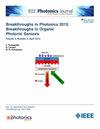具有多极辐射模式增强的高效偏振分集光栅耦合器
IF 2.4
4区 工程技术
Q3 ENGINEERING, ELECTRICAL & ELECTRONIC
引用次数: 0
摘要
二维衍射光栅在平面光子芯片和光纤之间提供了一种与偏振无关的耦合解决方案,具有放置灵活性、易于制造和对校准误差的容错性等优点。在这项工作中,我们首先提出并实验证明了一种高效的二维光栅耦合器,该耦合器通过双能级介电结构激发多极共振。采用70 nm浅蚀刻孔阵列和160 nm厚沉积多晶硅齿阵列构成二维光栅耦合器。因此,通过使用193nm深紫外(DUV)光刻技术,可以获得强光场约束和增强的辐射方向性,这很容易从商业硅光子学代工厂获得。实验测量到的耦合效率峰值为−2.54 dB,最小特征尺寸为180 nm。由于完全垂直耦合的好处,在我们的实验中,在3db的工作带宽内,测量到的极化相关损耗低于0.3 dB。我们提出的多极辐射模式增强二维光栅结构也可以应用于其他集成光学平台,实现光纤和光子芯片之间高效的偏振分集耦合,同时降低了对特征尺寸的要求。本文章由计算机程序翻译,如有差异,请以英文原文为准。
Efficient Polarization-Diversity Grating Coupler With Multipolar Radiation Mode Enhancement
Two-dimensional (2D) diffraction gratings offer a polarization-independent coupling solution between the planar photonic chips and optical fibers, with advantages including placement flexibility, ease of fabrication, and tolerance to alignment errors. In this work, we first proposed and experimentally demonstrated a highly efficient 2D grating coupler enabled by exciting multipolar resonances through bi-level dielectric structures. A 70-nm shallow-etched hole array and a 160-nm-thick deposited polycrystalline silicon tooth array are employed in our proposed 2D grating coupler. Strong optical field confinement and enhanced radiation directionality can thus be attained through the use of 193-nm deep-ultraviolet (DUV) lithography, which is readily accessible from commercial silicon photonics foundries. The measured experimental peak coupling efficiency is −2.54 dB with a minimum feature size of 180 nm. Due to the benefits of perfectly vertical coupling, the measured polarization-dependent loss in our experiments is below 0.3 dB within the 3-dB working bandwidth. Our proposed multipolar radiation mode enhanced 2D grating structure can also be applied to other integrated optics platforms, enabling an efficient and polarization-diversity coupling between optical fibers and photonic chips while reducing requirements on feature size.
求助全文
通过发布文献求助,成功后即可免费获取论文全文。
去求助
来源期刊

IEEE Photonics Journal
ENGINEERING, ELECTRICAL & ELECTRONIC-OPTICS
CiteScore
4.50
自引率
8.30%
发文量
489
审稿时长
1.4 months
期刊介绍:
Breakthroughs in the generation of light and in its control and utilization have given rise to the field of Photonics, a rapidly expanding area of science and technology with major technological and economic impact. Photonics integrates quantum electronics and optics to accelerate progress in the generation of novel photon sources and in their utilization in emerging applications at the micro and nano scales spanning from the far-infrared/THz to the x-ray region of the electromagnetic spectrum. IEEE Photonics Journal is an online-only journal dedicated to the rapid disclosure of top-quality peer-reviewed research at the forefront of all areas of photonics. Contributions addressing issues ranging from fundamental understanding to emerging technologies and applications are within the scope of the Journal. The Journal includes topics in: Photon sources from far infrared to X-rays, Photonics materials and engineered photonic structures, Integrated optics and optoelectronic, Ultrafast, attosecond, high field and short wavelength photonics, Biophotonics, including DNA photonics, Nanophotonics, Magnetophotonics, Fundamentals of light propagation and interaction; nonlinear effects, Optical data storage, Fiber optics and optical communications devices, systems, and technologies, Micro Opto Electro Mechanical Systems (MOEMS), Microwave photonics, Optical Sensors.
 求助内容:
求助内容: 应助结果提醒方式:
应助结果提醒方式:


